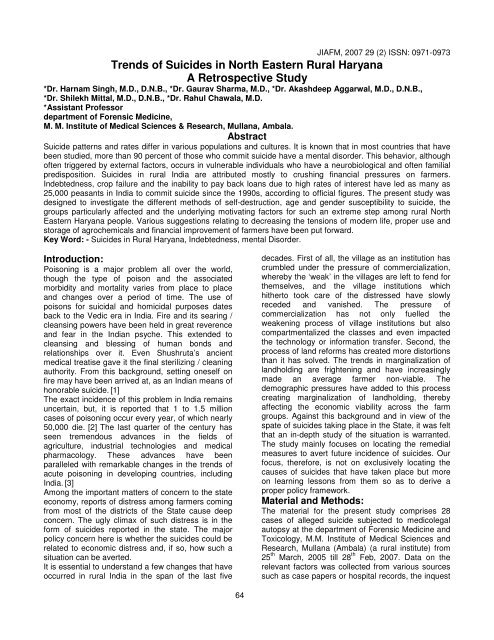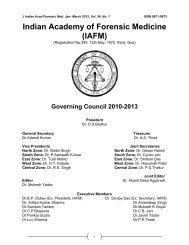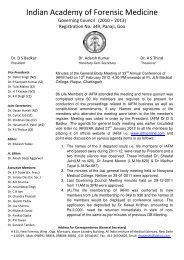Journal of Indian Academy of Forensic Medicine (JIAFM)
Journal of Indian Academy of Forensic Medicine (JIAFM)
Journal of Indian Academy of Forensic Medicine (JIAFM)
Create successful ePaper yourself
Turn your PDF publications into a flip-book with our unique Google optimized e-Paper software.
64<br />
<strong>JIAFM</strong>, 2007 29 (2) ISSN: 0971-0973<br />
Trends <strong>of</strong> Suicides in North Eastern Rural Haryana<br />
A Retrospective Study<br />
*Dr. Harnam Singh, M.D., D.N.B., *Dr. Gaurav Sharma, M.D., *Dr. Akashdeep Aggarwal, M.D., D.N.B.,<br />
*Dr. Shilekh Mittal, M.D., D.N.B., *Dr. Rahul Chawala, M.D.<br />
*Assistant Pr<strong>of</strong>essor<br />
department <strong>of</strong> <strong>Forensic</strong> <strong>Medicine</strong>,<br />
M. M. Institute <strong>of</strong> Medical Sciences & Research, Mullana, Ambala.<br />
Abstract<br />
Suicide patterns and rates differ in various populations and cultures. It is known that in most countries that have<br />
been studied, more than 90 percent <strong>of</strong> those who commit suicide have a mental disorder. This behavior, although<br />
<strong>of</strong>ten triggered by external factors, occurs in vulnerable individuals who have a neurobiological and <strong>of</strong>ten familial<br />
predisposition. Suicides in rural India are attributed mostly to crushing financial pressures on farmers.<br />
Indebtedness, crop failure and the inability to pay back loans due to high rates <strong>of</strong> interest have led as many as<br />
25,000 peasants in India to commit suicide since the 1990s, according to <strong>of</strong>ficial figures. The present study was<br />
designed to investigate the different methods <strong>of</strong> self-destruction, age and gender susceptibility to suicide, the<br />
groups particularly affected and the underlying motivating factors for such an extreme step among rural North<br />
Eastern Haryana people. Various suggestions relating to decreasing the tensions <strong>of</strong> modern life, proper use and<br />
storage <strong>of</strong> agrochemicals and financial improvement <strong>of</strong> farmers have been put forward.<br />
Key Word: - Suicides in Rural Haryana, Indebtedness, mental Disorder.<br />
Introduction:<br />
Poisoning is a major problem all over the world,<br />
though the type <strong>of</strong> poison and the associated<br />
morbidity and mortality varies from place to place<br />
and changes over a period <strong>of</strong> time. The use <strong>of</strong><br />
poisons for suicidal and homicidal purposes dates<br />
back to the Vedic era in India. Fire and its searing /<br />
cleansing powers have been held in great reverence<br />
and fear in the <strong>Indian</strong> psyche. This extended to<br />
cleansing and blessing <strong>of</strong> human bonds and<br />
relationships over it. Even Shushruta’s ancient<br />
medical treatise gave it the final sterilizing / cleaning<br />
authority. From this background, setting oneself on<br />
fire may have been arrived at, as an <strong>Indian</strong> means <strong>of</strong><br />
honorable suicide. [1]<br />
The exact incidence <strong>of</strong> this problem in India remains<br />
uncertain, but, it is reported that 1 to 1.5 million<br />
cases <strong>of</strong> poisoning occur every year, <strong>of</strong> which nearly<br />
50,000 die. [2] The last quarter <strong>of</strong> the century has<br />
seen tremendous advances in the fields <strong>of</strong><br />
agriculture, industrial technologies and medical<br />
pharmacology. These advances have been<br />
paralleled with remarkable changes in the trends <strong>of</strong><br />
acute poisoning in developing countries, including<br />
India. [3]<br />
Among the important matters <strong>of</strong> concern to the state<br />
economy, reports <strong>of</strong> distress among farmers coming<br />
from most <strong>of</strong> the districts <strong>of</strong> the State cause deep<br />
concern. The ugly climax <strong>of</strong> such distress is in the<br />
form <strong>of</strong> suicides reported in the state. The major<br />
policy concern here is whether the suicides could be<br />
related to economic distress and, if so, how such a<br />
situation can be averted.<br />
It is essential to understand a few changes that have<br />
occurred in rural India in the span <strong>of</strong> the last five<br />
decades. First <strong>of</strong> all, the village as an institution has<br />
crumbled under the pressure <strong>of</strong> commercialization,<br />
whereby the ‘weak’ in the villages are left to fend for<br />
themselves, and the village institutions which<br />
hitherto took care <strong>of</strong> the distressed have slowly<br />
receded and vanished. The pressure <strong>of</strong><br />
commercialization has not only fuelled the<br />
weakening process <strong>of</strong> village institutions but also<br />
compartmentalized the classes and even impacted<br />
the technology or information transfer. Second, the<br />
process <strong>of</strong> land reforms has created more distortions<br />
than it has solved. The trends in marginalization <strong>of</strong><br />
landholding are frightening and have increasingly<br />
made an average farmer non-viable. The<br />
demographic pressures have added to this process<br />
creating marginalization <strong>of</strong> landholding, thereby<br />
affecting the economic viability across the farm<br />
groups. Against this background and in view <strong>of</strong> the<br />
spate <strong>of</strong> suicides taking place in the State, it was felt<br />
that an in-depth study <strong>of</strong> the situation is warranted.<br />
The study mainly focuses on locating the remedial<br />
measures to avert future incidence <strong>of</strong> suicides. Our<br />
focus, therefore, is not on exclusively locating the<br />
causes <strong>of</strong> suicides that have taken place but more<br />
on learning lessons from them so as to derive a<br />
proper policy framework.<br />
Material and Methods:<br />
The material for the present study comprises 28<br />
cases <strong>of</strong> alleged suicide subjected to medicolegal<br />
autopsy at the department <strong>of</strong> <strong>Forensic</strong> <strong>Medicine</strong> and<br />
Toxicology, M.M. Institute <strong>of</strong> Medical Sciences and<br />
Research, Mullana (Ambala) (a rural institute) from<br />
25 th March, 2005 till 28 th Feb, 2007. Data on the<br />
relevant factors was collected from various sources<br />
such as case papers or hospital records, the inquest









